Bojun Cheng
SpikingMamba: Towards Energy-Efficient Large Language Models via Knowledge Distillation from Mamba
Oct 06, 2025
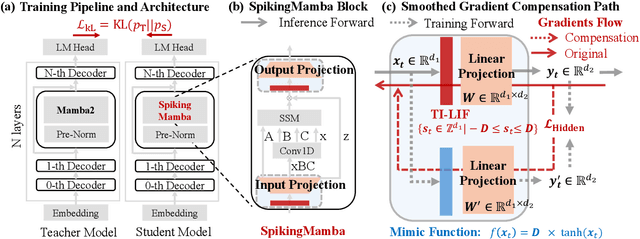


Abstract:Large Language Models (LLMs) have achieved remarkable performance across tasks but remain energy-intensive due to dense matrix operations. Spiking neural networks (SNNs) improve energy efficiency by replacing dense matrix multiplications with sparse accumulations. Their sparse spike activity enables efficient LLMs deployment on edge devices. However, prior SNN-based LLMs often sacrifice performance for efficiency, and recovering accuracy typically requires full pretraining, which is costly and impractical. To address this, we propose SpikingMamba, an energy-efficient SNN-based LLMs distilled from Mamba that improves energy efficiency with minimal accuracy sacrifice. SpikingMamba integrates two key components: (a) TI-LIF, a ternary-integer spiking neuron that preserves semantic polarity through signed multi-level spike representations. (b) A training-exclusive Smoothed Gradient Compensation (SGC) path mitigating quantization loss while preserving spike-driven efficiency. We employ a single-stage distillation strategy to transfer the zero-shot ability of pretrained Mamba and further enhance it via reinforcement learning (RL). Experiments show that SpikingMamba-1.3B achieves a 4.76$\times$ energy benefit, with only a 4.78\% zero-shot accuracy gap compared to the original Mamba, and achieves a further 2.55\% accuracy improvement after RL.
Event-Based Eye Tracking. 2025 Event-based Vision Workshop
Apr 25, 2025Abstract:This survey serves as a review for the 2025 Event-Based Eye Tracking Challenge organized as part of the 2025 CVPR event-based vision workshop. This challenge focuses on the task of predicting the pupil center by processing event camera recorded eye movement. We review and summarize the innovative methods from teams rank the top in the challenge to advance future event-based eye tracking research. In each method, accuracy, model size, and number of operations are reported. In this survey, we also discuss event-based eye tracking from the perspective of hardware design.
Exploring Temporal Dynamics in Event-based Eye Tracker
Mar 31, 2025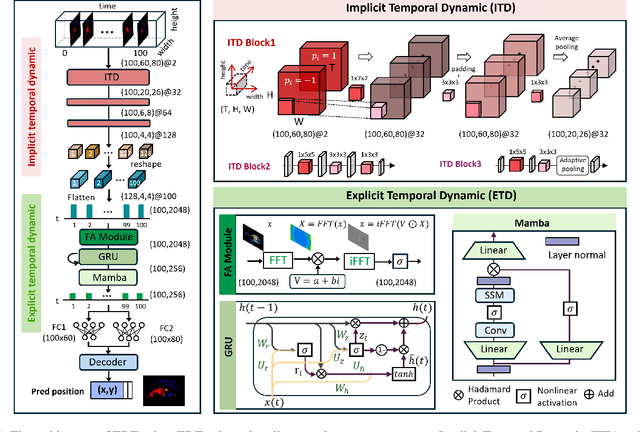
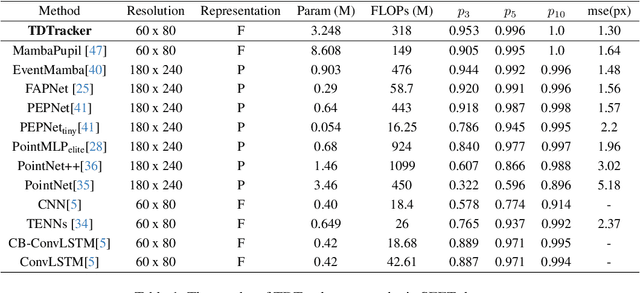
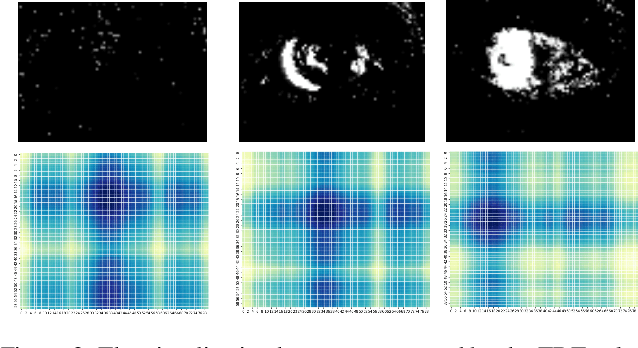

Abstract:Eye-tracking is a vital technology for human-computer interaction, especially in wearable devices such as AR, VR, and XR. The realization of high-speed and high-precision eye-tracking using frame-based image sensors is constrained by their limited temporal resolution, which impairs the accurate capture of rapid ocular dynamics, such as saccades and blinks. Event cameras, inspired by biological vision systems, are capable of perceiving eye movements with extremely low power consumption and ultra-high temporal resolution. This makes them a promising solution for achieving high-speed, high-precision tracking with rich temporal dynamics. In this paper, we propose TDTracker, an effective eye-tracking framework that captures rapid eye movements by thoroughly modeling temporal dynamics from both implicit and explicit perspectives. TDTracker utilizes 3D convolutional neural networks to capture implicit short-term temporal dynamics and employs a cascaded structure consisting of a Frequency-aware Module, GRU, and Mamba to extract explicit long-term temporal dynamics. Ultimately, a prediction heatmap is used for eye coordinate regression. Experimental results demonstrate that TDTracker achieves state-of-the-art (SOTA) performance on the synthetic SEET dataset and secured Third place in the CVPR event-based eye-tracking challenge 2025. Our code is available at https://github.com/rhwxmx/TDTracker.
ClearSight: Human Vision-Inspired Solutions for Event-Based Motion Deblurring
Jan 27, 2025



Abstract:Motion deblurring addresses the challenge of image blur caused by camera or scene movement. Event cameras provide motion information that is encoded in the asynchronous event streams. To efficiently leverage the temporal information of event streams, we employ Spiking Neural Networks (SNNs) for motion feature extraction and Artificial Neural Networks (ANNs) for color information processing. Due to the non-uniform distribution and inherent redundancy of event data, existing cross-modal feature fusion methods exhibit certain limitations. Inspired by the visual attention mechanism in the human visual system, this study introduces a bioinspired dual-drive hybrid network (BDHNet). Specifically, the Neuron Configurator Module (NCM) is designed to dynamically adjusts neuron configurations based on cross-modal features, thereby focusing the spikes in blurry regions and adapting to varying blurry scenarios dynamically. Additionally, the Region of Blurry Attention Module (RBAM) is introduced to generate a blurry mask in an unsupervised manner, effectively extracting motion clues from the event features and guiding more accurate cross-modal feature fusion. Extensive subjective and objective evaluations demonstrate that our method outperforms current state-of-the-art methods on both synthetic and real-world datasets.
Frequency-aware Event Cloud Network
Dec 30, 2024



Abstract:Event cameras are biologically inspired sensors that emit events asynchronously with remarkable temporal resolution, garnering significant attention from both industry and academia. Mainstream methods favor frame and voxel representations, which reach a satisfactory performance while introducing time-consuming transformation, bulky models, and sacrificing fine-grained temporal information. Alternatively, Point Cloud representation demonstrates promise in addressing the mentioned weaknesses, but it ignores the polarity information, and its models have limited proficiency in abstracting long-term events' features. In this paper, we propose a frequency-aware network named FECNet that leverages Event Cloud representations. FECNet fully utilizes 2S-1T-1P Event Cloud by innovating the event-based Group and Sampling module. To accommodate the long sequence events from Event Cloud, FECNet embraces feature extraction in the frequency domain via the Fourier transform. This approach substantially extinguishes the explosion of Multiply Accumulate Operations (MACs) while effectively abstracting spatial-temporal features. We conducted extensive experiments on event-based object classification, action recognition, and human pose estimation tasks, and the results substantiate the effectiveness and efficiency of FECNet.
Event-based Motion Deblurring via Multi-Temporal Granularity Fusion
Dec 16, 2024



Abstract:Conventional frame-based cameras inevitably produce blurry effects due to motion occurring during the exposure time. Event camera, a bio-inspired sensor offering continuous visual information could enhance the deblurring performance. Effectively utilizing the high-temporal-resolution event data is crucial for extracting precise motion information and enhancing deblurring performance. However, existing event-based image deblurring methods usually utilize voxel-based event representations, losing the fine-grained temporal details that are mathematically essential for fast motion deblurring. In this paper, we first introduce point cloud-based event representation into the image deblurring task and propose a Multi-Temporal Granularity Network (MTGNet). It combines the spatially dense but temporally coarse-grained voxel-based event representation and the temporally fine-grained but spatially sparse point cloud-based event. To seamlessly integrate such complementary representations, we design a Fine-grained Point Branch. An Aggregation and Mapping Module (AMM) is proposed to align the low-level point-based features with frame-based features and an Adaptive Feature Diffusion Module (AFDM) is designed to manage the resolution discrepancies between event data and image data by enriching the sparse point feature. Extensive subjective and objective evaluations demonstrate that our method outperforms current state-of-the-art approaches on both synthetic and real-world datasets.
PRF: Parallel Resonate and Fire Neuron for Long Sequence Learning in Spiking Neural Networks
Oct 04, 2024Abstract:Recently, there is growing demand for effective and efficient long sequence modeling, with State Space Models (SSMs) proving to be effective for long sequence tasks. To further reduce energy consumption, SSMs can be adapted to Spiking Neural Networks (SNNs) using spiking functions. However, current spiking-formalized SSMs approaches still rely on float-point matrix-vector multiplication during inference, undermining SNNs' energy advantage. In this work, we address the efficiency and performance challenges of long sequence learning in SNNs simultaneously. First, we propose a decoupled reset method for parallel spiking neuron training, reducing the typical Leaky Integrate-and-Fire (LIF) model's training time from $O(L^2)$ to $O(L\log L)$, effectively speeding up the training by $6.57 \times$ to $16.50 \times$ on sequence lengths $1,024$ to $32,768$. To our best knowledge, this is the first time that parallel computation with a reset mechanism is implemented achieving equivalence to its sequential counterpart. Secondly, to capture long-range dependencies, we propose a Parallel Resonate and Fire (PRF) neuron, which leverages an oscillating membrane potential driven by a resonate mechanism from a differentiable reset function in the complex domain. The PRF enables efficient long sequence learning while maintaining parallel training. Finally, we demonstrate that the proposed spike-driven architecture using PRF achieves performance comparable to Structured SSMs (S4), with two orders of magnitude reduction in energy consumption, outperforming Transformer on Long Range Arena tasks.
FAPNet: An Effective Frequency Adaptive Point-based Eye Tracker
Jun 05, 2024Abstract:Eye tracking is crucial for human-computer interaction in different domains. Conventional cameras encounter challenges such as power consumption and image quality during different eye movements, prompting the need for advanced solutions with ultra-fast, low-power, and accurate eye trackers. Event cameras, fundamentally designed to capture information about moving objects, exhibit low power consumption and high temporal resolution. This positions them as an alternative to traditional cameras in the realm of eye tracking. Nevertheless, existing event-based eye tracking networks neglect the pivotal sparse and fine-grained temporal information in events, resulting in unsatisfactory performance. Moreover, the energy-efficient features are further compromised by the use of excessively complex models, hindering efficient deployment on edge devices. In this paper, we utilize Point Cloud as the event representation to harness the high temporal resolution and sparse characteristics of events in eye tracking tasks. We rethink the point-based architecture PEPNet with preprocessing the long-term relationships between samples, leading to the innovative design of FAPNet. A frequency adaptive mechanism is designed to realize adaptive tracking according to the speed of the pupil movement and the Inter Sample LSTM module is introduced to utilize the temporal correlation between samples. In the Event-based Eye Tracking Challenge, we utilize vanilla PEPNet, which is the former work to achieve the $p_{10}$ accuracy of 97.95\%. On the SEET synthetic dataset, FAPNet can achieve state-of-the-art while consuming merely 10\% of the PEPNet's computational resources. Notably, the computational demand of FAPNet is independent of the sensor's spatial resolution, enhancing its applicability on resource-limited edge devices.
Rethinking Efficient and Effective Point-based Networks for Event Camera Classification and Regression: EventMamba
May 09, 2024Abstract:Event cameras, drawing inspiration from biological systems, efficiently detect changes in ambient light with low latency and high dynamic range while consuming minimal power. The most current approach to processing event data often involves converting it into frame-based representations, which is well-established in traditional vision. However, this approach neglects the sparsity of event data, loses fine-grained temporal information during the transformation process, and increases the computational burden, making it ineffective for characterizing event camera properties. In contrast, Point Cloud is a popular representation for 3D processing and is better suited to match the sparse and asynchronous nature of the event camera. Nevertheless, despite the theoretical compatibility of point-based methods with event cameras, the results show a performance gap that is not yet satisfactory compared to frame-based methods. In order to bridge the performance gap, we propose EventMamba, an efficient and effective Point Cloud framework that achieves competitive results even compared to the state-of-the-art (SOTA) frame-based method in both classification and regression tasks. This notable accomplishment is facilitated by our rethinking of the distinction between Event Cloud and Point Cloud, emphasizing effective temporal information extraction through optimized network structures. Specifically, EventMamba leverages temporal aggregation and State Space Model (SSM) based Mamba boasting enhanced temporal information extraction capabilities. Through a hierarchical structure, EventMamba is adept at abstracting local and global spatial features and implicit and explicit temporal features. By adhering to the lightweight design principle, EventMamba delivers impressive results with minimal computational resource utilization, demonstrating its efficiency and effectiveness.
Event-Based Eye Tracking. AIS 2024 Challenge Survey
Apr 17, 2024
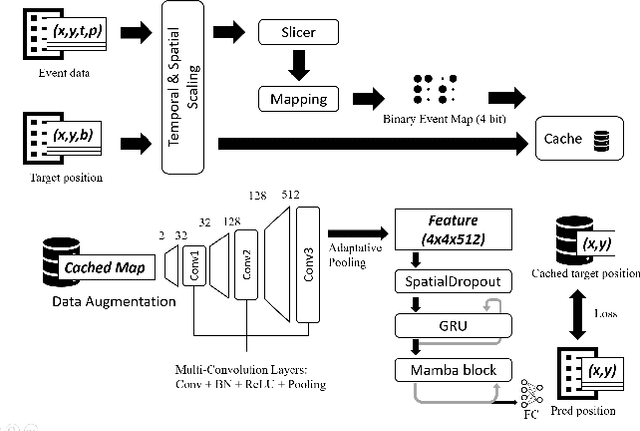
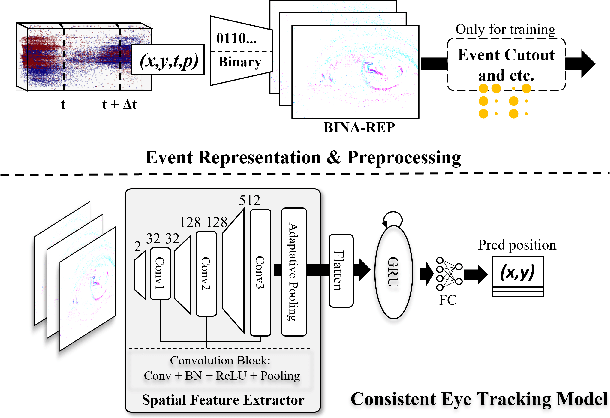

Abstract:This survey reviews the AIS 2024 Event-Based Eye Tracking (EET) Challenge. The task of the challenge focuses on processing eye movement recorded with event cameras and predicting the pupil center of the eye. The challenge emphasizes efficient eye tracking with event cameras to achieve good task accuracy and efficiency trade-off. During the challenge period, 38 participants registered for the Kaggle competition, and 8 teams submitted a challenge factsheet. The novel and diverse methods from the submitted factsheets are reviewed and analyzed in this survey to advance future event-based eye tracking research.
 Add to Chrome
Add to Chrome Add to Firefox
Add to Firefox Add to Edge
Add to Edge